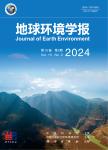Late Pleistocene/Early Holocene climate conditions of North Mongolia based on carbon and oxygen stable isotopes of Dood Lake sediments
Late Pleistocene/Early Holocene climate conditions of North Mongolia based on carbon and oxygen stable isotopes of Dood Lake sediments作者机构:Institute of Geology and mineral resourcesMongolian Academy of Sciences Korean Institute of Geosciences and Mineral Resources Institute of geology and mineralogy SB RAS Physics DepartmentUniversity of Arizona
出 版 物:《地球环境学报》 (Journal of Earth Environment)
年 卷 期:2011年第1期
页 面:318-320页
学科分类:070903[理学-古生物学与地层学(含:古人类学)] 0709[理学-地质学] 07[理学]
主 题:Lake Late Pleistocene/Early Holocene climate conditions of North Mongolia based on carbon and oxygen stable isotopes of Dood Lake sediments
摘 要:Lake Dood is a fresh water lake,remnant of a large glacial lake in the Darkhad *** Mongolia is located at the coordinate of 51°20’ N,99°23’E,in 1538 m a.s.l..The length of the lake is 7.5 km with mean width2.4 km(maximum width is 5.6 km).Mean depth of the lake Dood is 4.7 m,but deepest point is 17 *** total area is about 41.3 km;.The climate of the Darkhad Basin is extremely continental with a mean annual temperature range of 40 ℃ and a mean annual precipitation of 300;00 ***,the lake Dood occupies a transition zone between mountain and forest steppe ecosystems to the south and the coniferous forests to the *** of its unique geographic location,this region is very sensitive to climate changes and ideal place for paleoclimate *** paper makes an attempt to reconstruct the paleoclimate changes in Early Holocene and Late Pleistocene based on results of isotope geochemistry analysis of the core 1,obtained from the Lake Dood in North Mongolia,during the Mongolian-Russian joint expedition in summer of *** core 1 with length of 645 cm was taken from northern part of the lake,at coordinates of 51°24’26.0 N;99°19’ 30.7 *** depth is 3.5 *** cores were cut lengthwise and after lithological description,it had been subsampled in 2 cm *** water,organic matter and carbonate contents of sediments were determined by heating the selected 210 samples(approximately 5;0 cm intervals) at 105℃,550℃ and 1000℃,*** isotope ratios of carbon and oxygen on bulk carbonate in 160 sediment samples were determined on Finnigan Mat 252 mass spectrometer at Key laboratory of Lanzhou Institute of Geology,Chinese Academy of *** ratios are reported relative to the Pee Dee Belemnite(PDB) standard for carbon and oxygen isotope measurements on bulk CO,.Plant fragments,wood debris and shells from 11 samples from different horizons of core 1 were dated by using Accelerator Mass Spectrometry at the University of Arizon



